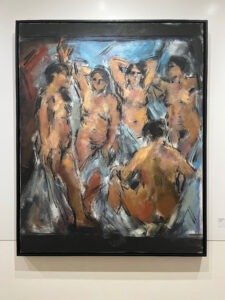What is love? In Ghislaine Howard’s exhibition of paintings at Manchester’s Contemporary Six Gallery, love is momentary and glimpsed, quick and immediate.
The artist’s eye is the beholder of that love, moved to explore those deep feelings with charcoal stick and paint brush. But do not mistake this for sweet sentimentality. This is a fierce gaze from Howard as she paints her every day into a commentary on female perspective and excavates art history to tell her own stories.

Tea in the studio. Photo by Nancy Collantine.
Nearly every painting in the exhibition offers an intimate moment in the daily lives of Howard, her daughter and her grandchild. A closer look reveals that it traces a direct lineage from the paintings of French Impressionist painter Berthe Morisot, whose subject matter and handling of paint has been a significant influence in Howard’s practice since she was a fine art student at Newcastle University.
Like Morisot, Howard’s paintings are often in a semi-state of collapse; she takes liberties in her drawing of the figure in favour of immediacy and energy in order to keep the painting alive. The portrait of Howard’s daughter holding the baby in Tea in the studio captures a mother drinking a cup of tea in a rare minute of self-preservation. The wriggling infant and the firm hand are barely holding it together in terms of the painting, yet it is secured by the lightly controlled composition and bound by warm colour. A painting within the painting offers the viewer a window into the past while reflecting Howard’s own relationship with her daughter as a child and the idea of eternal motherhood.
In Howard’s Les Demoiselles d’Avignon Re-imagined, the viewer is presented with a soft assembly of female figures as opposed to Picasso’s original Cubist painting of an organised and angular crew of masked characters confronting the viewer. Howard wanted to explore how Picasso made the painting, working in collaboration with the life model Marissa Burgess, to see how possible the poses were to hold for a real woman and technically how to get the bodies into the space.

Les Demoiselles d’Avignon Re-imagined. Photo by Nancy Collantine.
“As someone who has used my own body to draw from as well as life models, when I look at female figure in painting, I try to inhabit that space and try to empathise with the model,” says Howard. “I wanted to pay respect to those real women who were so brutally rendered in Picasso’s painting and remember them for being women. I was interested in how to fit all those figures into the space, the contortion of the bodies and how that contributed to the de-humanisation of the subjects. It was an experiment with a painting that I have long been fascinated with.”
The final word goes to the tiny painting Circus Rider, one of a series Howard made in response to Yeats’ poem The Circus Animal’s Desertion in which the following lines provide the encouragement to look to what you know and what is inside you, an abiding philosophy that shines throughout this minor retrospective in Howard’s distinguished artistic career.
‘Now that my ladder’s gone
I must lie down where all the ladders start
In the foul rag and bone shop of the heart.’
All photographs taken by Nancy Collantine
The Fragile Thread, a retrospective of paintings by Ghislaine Howard, is at Contemporary Six until September 28, 2025. For more information, click here.









